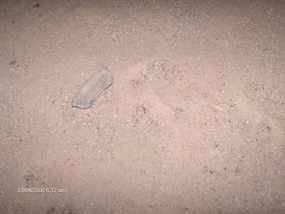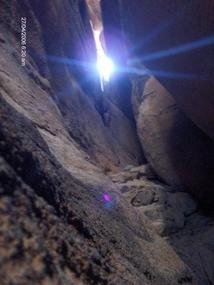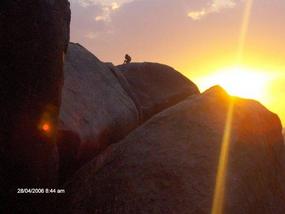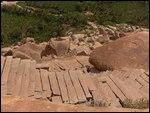Coming down from the temple, I found a small archway cut into the stone, and exploring further, there was a path, sometimes hidden behind a rock which I followed. Bats were startled, flying overhead with their "sonar" squeaking at a high pitch which was more felt than heard. Remembering scare stories as a kid of bats getting caught in a person's hair and biting them, I tied my red bandanna over my hair in a "do-rag" style, and pulled out my mini-maglight with which to navigate the narrow passages of the cave.
The cave went deep into the mountain, sometimes I had to squeeze through narrow spaces barely big enough for a 6 foot westerner, no matter how thin I may have become, and also sometimes I had to duck low for the ever-present bats, flying inches above my head, ready to give me a rabid bite
.
At length the cave opened out into a small room containing an altar for pooja, presumably for the destroyer god Shiva, and also sanskrit writing. Perhaps some kind of ancient graffitti "rajneesh was here, year 1356," or maybe "watch out for the bats."
The way the sun shone through the gaps in the rock was sometimes eerie, sometimes beautiful. Exiting that cave, I proceeded up and then down the secret staircase to find another post-and lintel shrine overlooking Hampi, and in full view of the Hanuman temple, some 2 kilometers distant. Quite a view.
At some places I looked for more entrances, once coming upon a sort of crevasse so deep that the feeble light from my tiny torch could not penetrate the gloom. I decided to push on and find an entrance to this one, which came another couple of hundred meters away, a statue of gonesh carved into the bare rock face guarding the entrance.
This was a bigger cave, full of twists and turns, the shells of giant millipedes everywhere, and sadly, also there was much trash at the opening
. As I went deeper, however, the trash dissapated, perhaps the litterbugs had been punished by Shiva, Gonesh, or a hungry leopard, which, I found out later are known to live in these caves.
On I went, finding yet more of the ancient writings, probably reading, "go away white man," or "here there by Tygers." Fortunately I did not come across any human bones or skulls, but one's mind tends to think about such things when running wild as you trudge through the dark.
One must eat this fear, however, if one is to see what others do not. Coming upon a huge deep hole in the trail that I could not cross, I looked down to see a large print, a little like a dog print, only larger. Next to it was a pottery shard, which I looked at and left there. A leopard print, old, but nonetheless. So my decision was made not to go down there in the dark, running into Shiva would be bad enough, but an angry leopard might have a little more immmediate consequences than a karmic punishment from an irate hindu demigod.
Explored a few more avenues, finding stairs and paths in unlikely places, and one could certainly spend a whole day or more just in that one mountain of caves. Of course I would not recommend this for those that cannot find their car in a parking lot, or have to ask directions every block, because the way out and in is not clear-cut, and one must remember very well which way they have come, or they may never be seen again, their mummified corpse pointing the way like something from "journey to the center of the earth
. . ."
Down back toward the village, I stepped on a rock to a strange hollow sound. "wait a minute," I thought, and turned around and tapped on the refrigerator-sized piece of granite. Ting, ting. . This was one of the musical rocks, the most famous being the pillars in the Varkala temple, though they discourage people from "playing" the pillars to preclude wear on the ancient monument.
On a side note, I viewed Varkala from the outside, and then from above, the cost being 200 rupees, which I thought better put into Rocinante's tank than spent looking at things of which I had seen many. . It would have been worth it, but as I am looking at a somewhat limited budget, I took a miss on that one. Oh, and incidentally they make no secret about "Indian price" and "western price." The indians pay 20 rupees to see varkala, while the westerners pay ten times that. I guess I need to really work on that tan and my scanty Hindi to get the discount. .
I rested by Nandi on the way down, and then played guitar at the Gopi, and after another beautiful sunset I turned in.
Tomorrow I was going to try to cross the river in one of the strange "coracle" boats they make from bamboo and old tarpaulins. . .
Hampi part 3, caves and musical stones
Tuesday, April 25, 2006
 Hampi, India
Hampi, India
Other Entries
-
16Mapusa. . .
Mar 3026 days prior Mapusa, Goa, Indiaphoto_camera5videocam 0comment 0
Mapusa, Goa, Indiaphoto_camera5videocam 0comment 0 -
17The dark side of Paradise. .
Mar 3125 days prior Arambol, Goa, Indiaphoto_camera3videocam 0comment 0
Arambol, Goa, Indiaphoto_camera3videocam 0comment 0 -
18Language theory, and so many choices.
Apr 0223 days prior Arambol, Indiaphoto_camera2videocam 0comment 0
Arambol, Indiaphoto_camera2videocam 0comment 0 -
19Dead and rotting things on the beach.
Apr 0322 days prior Arambol, Goa, Indiaphoto_camera3videocam 0comment 0
Arambol, Goa, Indiaphoto_camera3videocam 0comment 0 -
20Rocinante gets to gallop
Apr 0619 days prior Palolem, Indiaphoto_camera5videocam 0comment 0
Palolem, Indiaphoto_camera5videocam 0comment 0 -
21Itchy feet and fading smiles.
Apr 0916 days prior Palolem Beach, Indiaphoto_camera5videocam 0comment 0
Palolem Beach, Indiaphoto_camera5videocam 0comment 0 -
22Scams advice, and "The Crew". .
Apr 1312 days prior Palolem Beach, Indiaphoto_camera5videocam 0comment 1
Palolem Beach, Indiaphoto_camera5videocam 0comment 1 -
23The time machine, The Darkness and The Light. .
Apr 187 days prior Palolem beach, Indiaphoto_camera5videocam 0comment 0
Palolem beach, Indiaphoto_camera5videocam 0comment 0 -
24Going Native
Apr 214 days prior Still in Palolem, Indiaphoto_camera5videocam 0comment 0
Still in Palolem, Indiaphoto_camera5videocam 0comment 0 -
25Leaving Palolem. .
Apr 223 days prior Palolem, Indiaphoto_camera5videocam 0comment 0
Palolem, Indiaphoto_camera5videocam 0comment 0 -
26Hard Core Karnataka: part 1
Apr 232 days prior Yaragatti, Karnataka, Indiaphoto_camera2videocam 0comment 0
Yaragatti, Karnataka, Indiaphoto_camera2videocam 0comment 0 -
27Hard Core Karnataka: part 2
Apr 232 days prior Yaragatti, Karnataka, Indiaphoto_camera4videocam 0comment 0
Yaragatti, Karnataka, Indiaphoto_camera4videocam 0comment 0 -
28Hard Core Karnataka: part 3
Apr 232 days prior Yaragatti, Karnataka, Indiaphoto_camera5videocam 0comment 0
Yaragatti, Karnataka, Indiaphoto_camera5videocam 0comment 0 -
29The long road to Hampi: Part 1
Apr 241 day prior Hampi, Karnataka, Indiaphoto_camera5videocam 0comment 0
Hampi, Karnataka, Indiaphoto_camera5videocam 0comment 0 -
30The long road to Hampi: part 2
Apr 241 day prior Hampi, Karnataka, Indiaphoto_camera5videocam 0comment 0
Hampi, Karnataka, Indiaphoto_camera5videocam 0comment 0 -
31Hampi part 1
Apr 25earlier that day Hampi, Indiaphoto_camera5videocam 0comment 0
Hampi, Indiaphoto_camera5videocam 0comment 0 -
32Hampi part 2, Hampi Magic
Apr 25earlier that day Hampi, Karnataka, Indiaphoto_camera5videocam 0comment 0
Hampi, Karnataka, Indiaphoto_camera5videocam 0comment 0 -
33Hampi part 3, caves and musical stones
Apr 25 Hampi, Indiaphoto_camera5videocam 0comment 0
Hampi, Indiaphoto_camera5videocam 0comment 0 -
34Hampi part 4, temples and coracles
Apr 261 day later Hampi, Indiaphoto_camera5videocam 0comment 0
Hampi, Indiaphoto_camera5videocam 0comment 0 -
35Hampi part 5, Hanuman, the monkey king.
Apr 272 days later Hampi, Karnataka, Indiaphoto_camera5videocam 0comment 0
Hampi, Karnataka, Indiaphoto_camera5videocam 0comment 0 -
36Hampi part 6, Kiran and the plantation
Apr 283 days later Hampi, Indiaphoto_camera5videocam 0comment 0
Hampi, Indiaphoto_camera5videocam 0comment 0 -
37The way to Mysore. .
May 016 days later Mysore, Indiaphoto_camera5videocam 0comment 0
Mysore, Indiaphoto_camera5videocam 0comment 0 -
38Mysore.
May 027 days later Mysore, Indiaphoto_camera5videocam 0comment 0
Mysore, Indiaphoto_camera5videocam 0comment 0 -
39Oooty and beyond.
May 0510 days later Ooty, Tamil Nadu, Indiaphoto_camera5videocam 0comment 0
Ooty, Tamil Nadu, Indiaphoto_camera5videocam 0comment 0 -
40Much ado about Mirayoor.
May 0611 days later Mirayoor, Kerala, Indiaphoto_camera5videocam 0comment 0
Mirayoor, Kerala, Indiaphoto_camera5videocam 0comment 0 -
41Mirayoor, and John.
May 0712 days later Mirayoor., Indiaphoto_camera5videocam 0comment 0
Mirayoor., Indiaphoto_camera5videocam 0comment 0 -
42Waterfalls and Tea plantations.
May 0813 days later Mirayoor, Indiaphoto_camera5videocam 0comment 0
Mirayoor, Indiaphoto_camera5videocam 0comment 0 -
43Munnar at last! And, the elusive Eugene. .
May 0813 days later Munnar, Kerala, Indiaphoto_camera5videocam 0comment 2
Munnar, Kerala, Indiaphoto_camera5videocam 0comment 2 -
44Another beach town. . .
May 1015 days later Varkalla, India, Indiaphoto_camera5videocam 0comment 0
Varkalla, India, Indiaphoto_camera5videocam 0comment 0 -
45The Misty mountain Hop. .
May 1520 days later Munnar/Marayoor, and beyond. ., Indiaphoto_camera5videocam 0comment 0
Munnar/Marayoor, and beyond. ., Indiaphoto_camera5videocam 0comment 0 -
46Mysore again. .
May 1823 days later Mysore, Indiaphoto_camera5videocam 0comment 0
Mysore, Indiaphoto_camera5videocam 0comment 0 -
47Three days in an Indian prison cell. . . .
May 1924 days later Mysore, Indiaphoto_camera5videocam 0comment 0
Mysore, Indiaphoto_camera5videocam 0comment 0 -
48Bangalore Bangs!
May 2227 days later Bangalore, Indiaphoto_camera5videocam 0comment 0
Bangalore, Indiaphoto_camera5videocam 0comment 0 -
49Kottakota 460 km in one day.
May 2429 days later Kottakota, Indiaphoto_camera6videocam 0comment 0
Kottakota, Indiaphoto_camera6videocam 0comment 0 -
50Up To Date at last!
May 2530 days later Hyderabad, Indiaphoto_camera5videocam 0comment 0
Hyderabad, Indiaphoto_camera5videocam 0comment 0 -
51Rocinante gets a checkup, the parting of the ways.
May 2631 days later Hyderabad, Indiaphoto_camera5videocam 0comment 0
Hyderabad, Indiaphoto_camera5videocam 0comment 0

 Hampi, India
Hampi, India





2025-05-22